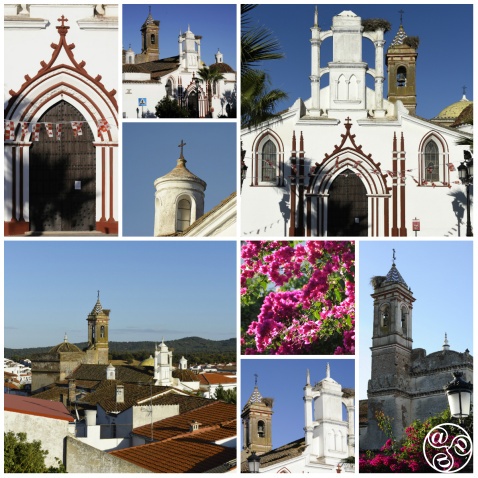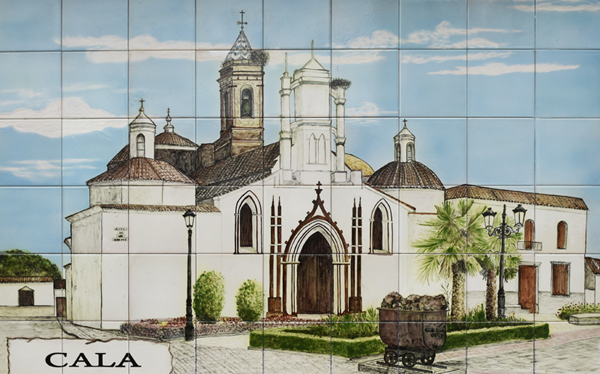
The village of Cala in the Sierra de Aracena |
|
Cala
This town is a few kilometres from the border with the region of Extremadura and the province of Badajoz. Its population is about 1300. Cala is within the Parque Natural de la Sierra de Aracena y Picos de Aroche. The name Cala comes from the Latin word callentum meaning beautiful.
THINGS TO SEE
Castle
The best place to capture stunning panoramic views is from the top of the hill overlooking the town where the 13th-century Moorish castle is located. This fortress was later reconstructed by the Christians. It used to have a number of towers. Park just off the main street Avenida Virgin de Cala and walk up to the castle. More >
Plaza del los Mineros
This square is a good place to stop for a drink at a café and take in the village atmosphere. Park on or just off the main street, Avenida Virgen de Cala. On the square are the Iglesia de la Magdalena, the Monumento a los Mineros, and the modern town hall. The square has ornate tiled benches and tiled fountains. More >
Monumento a los Mineros
This monument, of a small old mining railway truck loaded with minerals, is located in the Plaza del los Mineros.
Iglesia de la Magdalena
Iglesia de la Magdalena was constructed between 13th and 16th century, and is originally in Gothic and mudéjar style; you can also observe other styles from later reforms and reconstructions. Actually the two towers and the front and rear facades are so different they look like two different churches. More>
Ermita de Nuestra Señora de Cala
This dates from the middle of the 13th century and is a rare example of late Romantic/early Gothic style found in the province of Huelva.
Casa Jardín
This house in Calle Fuente boasts a beautiful baroque entrance and magnificent interior garden.
Fountains
There are a number of interesting fountains in Cala, such as the ones in Plaza de la Cruz, Calle Rodrigo the aptly-named Calle Fuente.
Hotels near Cala
Book Hotels near Cala
History
In Roman times there was a settlement here called Restituta Llulia, known for the quality of its clay bricks. The Moors built the castle during their occupation. The reconquest of Cala and surrounding area was carried out by Ferdinand III from 1246 to 1248, and after his death his son Alfonso X El Sabio passed the estate to the Señorio de Sevilla. In the 16th century Cala was known for quality glass production.
In the Spanish territorial reform of 1833 the province of Huelva was created and Cala passed from Reino de Sevilla to Province of Huelva.
Country Walks
A number of signed footpaths start from Cala through the park. One of the most popular leads to the old mining village of Minas de Cala.
There is also a zona recreativa (recreation area) with picnic tables and barbeque stations called Dehesa Tres Encinas just off the A-434 in the direction of Arroyomolinos de León at the small Ermita de San Roque.
Mining Villages
Around Cala are a number of small hamlets whose origin is the mining industry - poblados mineros (mining towns) - Minas de Cala, Mina La Sultana and Minas de Teuler. The mine railway, built at the end of the 19th century, transported minerals and passengers until 1936, from Minas de Cala south to San Juan de Aznalfarache in Seville. Part of the route is now a Via Verde, for walking and cycling, and a public campaign is demanding that more of the old railway line also be converted.
Handicrafts
The local handicrafts of Cala are ceramics, embroidery, leatherwork, bone and wooden carvings.
Gastronomy
The local gastronomy consists of mosto de cañamón (hemp seed wine), pork sausages, guarrito frito (fried suckling lamb/pig), goat stew, and gazpacho. Among its pastries are bollas greaves (lard and cinnamon rolls) fritters and perrunillas (almond and wine biscuits).
Festivals
Carnaval - the colourful pre-Lent celebration, takes place in in February/March. Cruces de Mayo - decorated crosses, is on and around 3 May. The Romería de San Roque is on the last weekend in May, from the village to the Ermita San Roque in the Dehesa Tres Encinas. The Feria de Cala is celebrated at the beginning of September.
Location
Cala is 85km north of Seville and 130 km north-east of Huelva. From either city join the N-630 Ruta de la Plata heading north, leave at Santa Olalla de la Cala and take the A-434 to Cala. The A-434 continues to Arroyomolinos de León. There is a country road, the HU-3126 to the mining village of Minas de Cala. Here there are various scenic activities that you can do. In October 2025, there is an Eco Festival being held near here for young children and adults.

